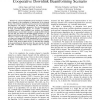Free Online Productivity Tools
i2Speak
i2Symbol
i2OCR
iTex2Img
iWeb2Print
iWeb2Shot
i2Type
iPdf2Split
iPdf2Merge
i2Bopomofo
i2Arabic
i2Style
i2Image
i2PDF
iLatex2Rtf
Sci2ools
VTC
2010
IEEE
2010
IEEE
On Non-Stationary Urban Macrocell Channels in a Cooperative Downlink Beamforming Scenario
—A common simplification in the treatment of random linear channels is the assumption of stationarity of the channel in time. The wireless channel is, however, known to be inherently non-stationary. We detail a methodology for non-stationarity analysis from an algorithmic perspective. For the determination of local quasi-stationarity regions, we consider a multi-link downlink scenario where multiple base stations use transmit beamforming to concurrently transmit to a single mobile terminal per time slot. We obtain an algorithm-specific measure, i.e., the signal-to-interference-plus-noise ratio (SINR) degradation, with which we evaluate local quasi-stationarity regions. Furthermore, we relate and compare the SINR degradation to the correlation matrix distance (CMD). In an urban macrocell scenario relevant to 3GPP Long Term Evolution (LTE), we find that the resulting local quasi-stationarity distances show the same trends, but that the CMD overestimates the average distances for our...
3gpp Long Term Evolution | Communications | Local Quasi-stationarity Regions | VTC 2010 | —A Common Simplification |
| Added | 31 Jan 2011 |
| Updated | 31 Jan 2011 |
| Type | Journal |
| Year | 2010 |
| Where | VTC |
| Authors | Adrian Ispas, Gerd Ascheid, Christian Schneider, Reiner S. Thomä |
Comments (0)

